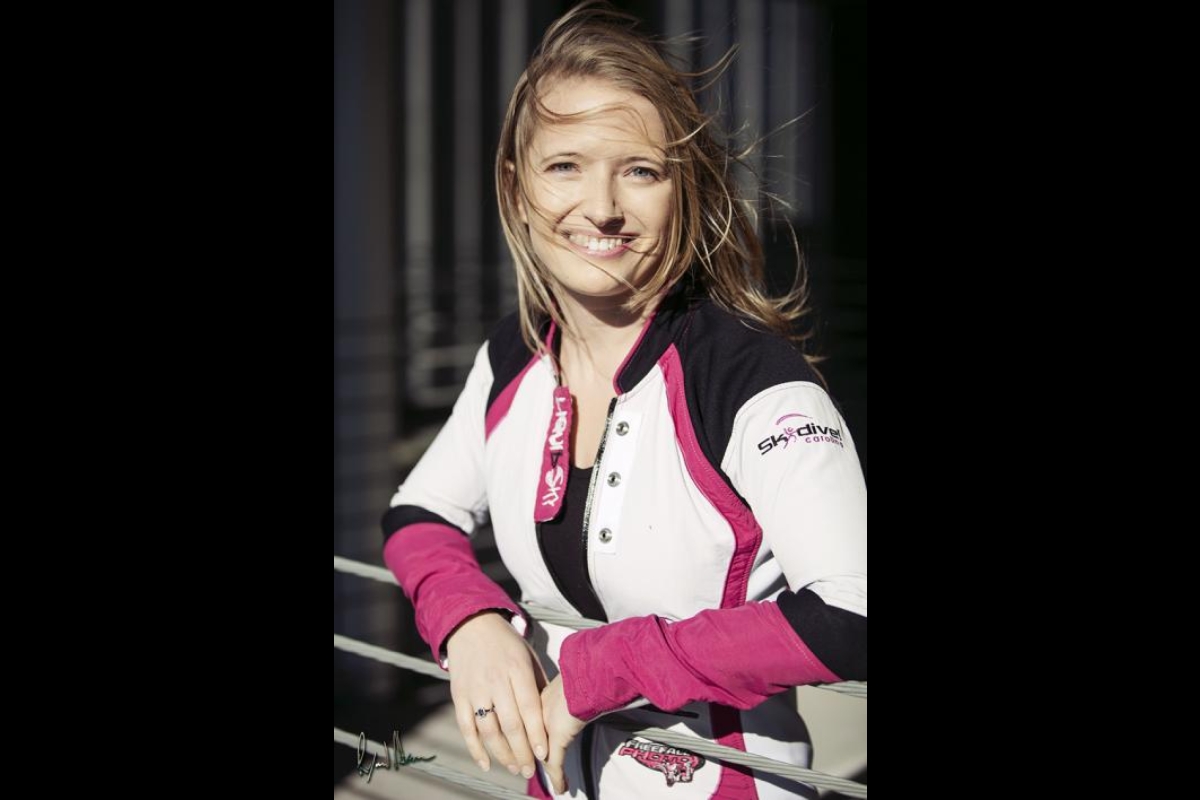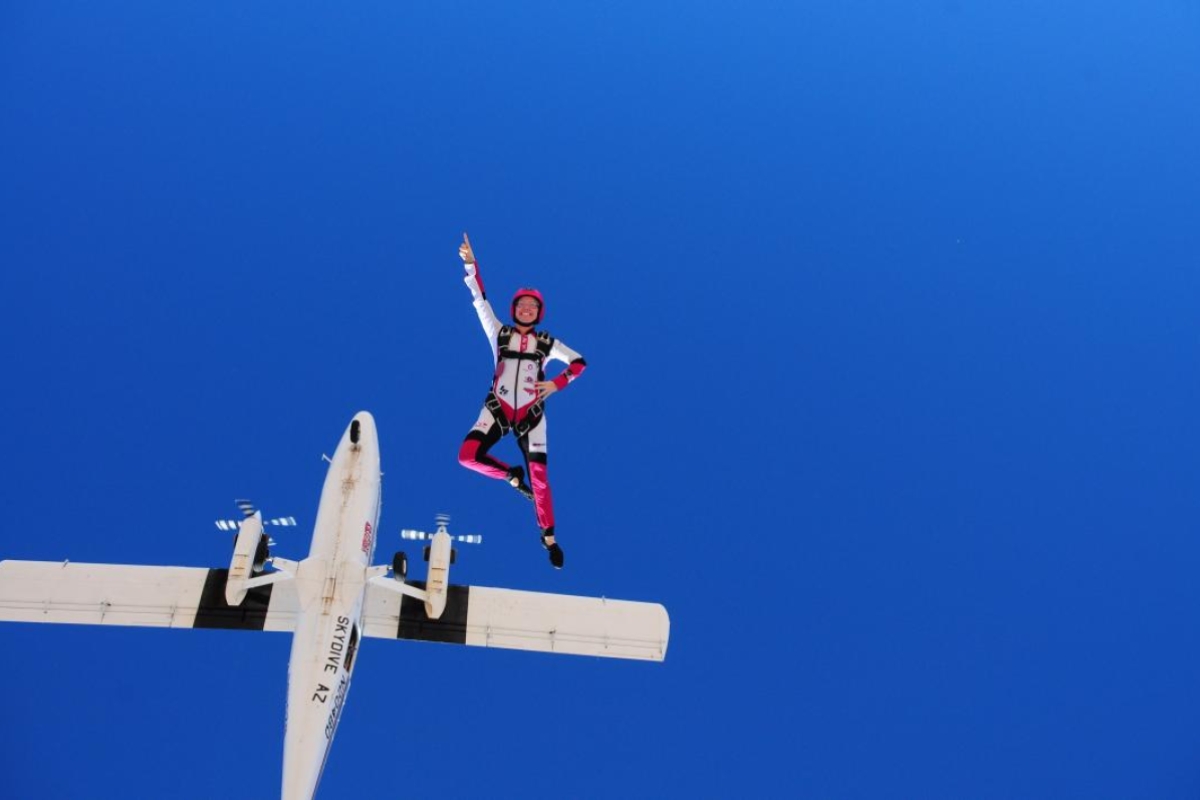Should engineers take more risks in the classroom? Skydiving professor says yes

If you are an engineering doctoral student with excess funding from a graduate fellowship, do you put it toward upgrading your car or training to become a skydiver?
Associate professor Nadia Kellam chose skydiving, and her engineering career and skydiving escapades have been intertwined ever since.
During her mechanical engineering doctoral studies, Kellam became a certified skydiving instructor. As an engineering faculty member at the University of Georgia, she also entered professional skydiving competitions.
Her skydiving and engineering careers continued to take off. Between 2012 and 2014, she not only earned tenure, but also second- and third-place finishes in the United States Parachute Association’s National Skydiving Championships.
Now at Arizona State University, Kellam not only experiences risk firsthand as she falls from the sky, performs as a flying-trapeze artist and cruises on her motorcycle, but she also researches the role of risk taking in the classroom.
Kellam is among a group of engineering education researchers from the Polytechnic School, one of the Ira A. Fulton Schools of Engineering, inciting revolution in engineering education. With funding from the National Science Foundation’s Revolutionizing Engineering Departments (RED) program, the group is, in part, examining how sustaining a mind-set of risk taking in the classroom can produce engineering graduates ready and excited to tackle society’s most pressing challenges.
Through her studies in narrative inquiry, Kellam interviews students and analyzes the motivations and factors that develop their identity as engineers.
Frequently students find their way to engineering because they’re good at math and science or want to make money and have career stability, she finds.
“Although these are valid reasons, they reflect a limitation in engineering education to attract a critical mass of students interested and committed to addressing the grand challenges of today,” Kellam said.
“Diversifying the engineering workforce with the inclusion of different perspectives, life stories and experiences is vital to meeting society’s engineering needs,” she added.
Creating an educational culture that values risk taking will enable students to go beyond textbook problems and extrinsic rewards. Students can become systems thinkers who understand and contribute to big, complex problems, while also exhibiting technical prowess.
This approach can change a university’s ability to attract students who may not have been considering engineering, but have a great deal to offer to the field.
ASU’s RED team, led by Ann McKenna, director of the Polytechnic School, is finding that a risk-taking culture in the classroom both attracts and prepares this impact-oriented type of engineering student.
“Risk taking in the classroom prepares students to ask critical questions and produces graduates who pursue careers that promise to make an impact after graduation,” Kellam said.
But producing these type of students requires risk taking to start at an institutional and faculty level.
“It can be hard for teachers to break out of the teach-by-the-textbook mold,” said Kellam, referring to this as a safe and traditional approach to engineering education. If teachers only teach by the textbook, students are likely to go on to only solve problems by the textbook or to avoid challenges that go beyond basic vocational training.
“Inciting a revolution in engineering education can start with creating a risk-seeking culture that helps and encourages faculty to step out of their comfort zone and try new approaches to instruction,” Kellam said.
One approach ASU’s RED team champions in the Polytechnic School’s engineering program is creating safe spaces where faculty members gather to reflect on their efforts to try innovative instructional methods. These groups provide a place where faculty members can receive constructive feedback and support for taking risks and trying to enable positive change, whether it’s immediately successful or not.
“By empowering and rewarding risk taking among faculty and students we create a culture of change agents [within the Fulton Schools] where everyone is able to modify and innovate the curriculum and learning experience, and this can lead to amazing transformation,” McKenna said.
Kellam is taking a risk this semester by incorporating peer instruction and reflection throughout her mechanical engineering class.
“Even if it doesn’t work perfectly I know it can be revised the next time around,” Kellam said.
She also regularly invites faculty to observe her classes and takes time to observe other classes in an effort to learn from her colleagues’ successes and failures.
“Nadia is a great example of our faculty in the Fulton Schools and the Polytechnic School. Her approach represents the forward-thinking and collaborative culture we have both in terms of teaching and research,” McKenna said.
Kellam said ASU is well suited for this type of environment. During her hiring interview she recalls former engineering dean Paul Johnson saying, “One thing that is always true is that we like change at ASU.” This message spoke to Kellam and was key in attracting her to the Fulton Schools faculty.
“At ASU we aren’t terrified of the idea of doing things differently. Here, progressive change is valued and permeates throughout the institution from our research labs to classrooms,” Kellam said.
“I do like showcasing that you can be an engineer and also have balance and other interests in your life.”
— Nadia Kellam, ASU associate professor of engineering
She recognizes that fear of new things can be debilitating, but she also encourages faculty and students to not let fear distract them.
“As a skydiver, fear is a distraction that can make things more dangerous in the moment,” Kellam said.
This fear can translate to teaching.
“If a faculty member fears bad evaluations, then that fear can impact the way they teach and cause paralysis in their teaching methods — prohibiting them from taking risks that might benefit students,” Kellam said.
She will be the first to admit she doesn’t fit the typical professor mold.
“I do like showcasing that you can be an engineer and also have balance and other interests in your life,” Kellam said.
Her ability to maintain balance has been an inspiration to her colleagues and students.
“Sometimes people need to be empowered to be a professional human. Nadia pushes me to answer the challenging questions in my research, while still pursuing the balance that I need personally to thrive,” said Brooke Coley, an associate research scientist on Kellam’s research team.
Emily Coutts, a sophomore engineering student, said she was “impressed and surprised” to have a professor who is into extreme sports.
“It’s beneficial when a professor can relate real-world examples to class work,” said Coutts. “It helps me to visualize the material and think about how to apply it outside the classroom.”
Kellam said her students might find her a little unusual, but when she explains engineering mechanics by talking about her firsthand experience with the statics and dynamics used in trapeze rigs, they pay attention.
Top photo by Robin Kellam
More Science and technology

ASU and Deca Technologies selected to lead $100M SHIELD USA project to strengthen U.S. semiconductor packaging capabilities
The National Institute of Standards and Technology — part of the U.S. Department of Commerce — announced today that it plans to award as much as $100 million to Arizona State University and Deca…

From food crops to cancer clinics: Lessons in extermination resistance
Just as crop-devouring insects evolve to resist pesticides, cancer cells can increase their lethality by developing resistance to treatment. In fact, most deaths from cancer are caused by the…

ASU professor wins NIH Director’s New Innovator Award for research linking gene function to brain structure
Life experiences alter us in many ways, including how we act and our mental and physical health. What we go through can even change how our genes work, how the instructions coded into our DNA are…


